FRIDAY, JUNE 10
■ After dark, spot Spica sparkling 10° to the right of the Moon. At a distance of 260 light-years, Spica is 6.4 billion times farther from us than the Moon is — the Moon is a mere stone's throw away at 1.3 light-seconds. A scale model: If the Moon was a dot of white paint on your window just two feet from your eye, Spica would be ten times farther than the real Moon's actual distance!
Look about a fist and a half lower right of Spica, and there are the four brightest stars of sail-shaped Corvus, the Crow.
SATURDAY, JUNE 11
■ The Big Dipper hangs high in the northwest as the stars come out. The Dipper's Pointers, currently its bottom two stars, point lower right toward Polaris. Above Polaris, and looking very similar to it, is Kochab, the lip of the dim Little Dipper's bowl.
Kochab stands precisely above Polaris around the end of twilight or a little after. How accurately can you time this event for your location, perhaps using the vertical edge of a building?
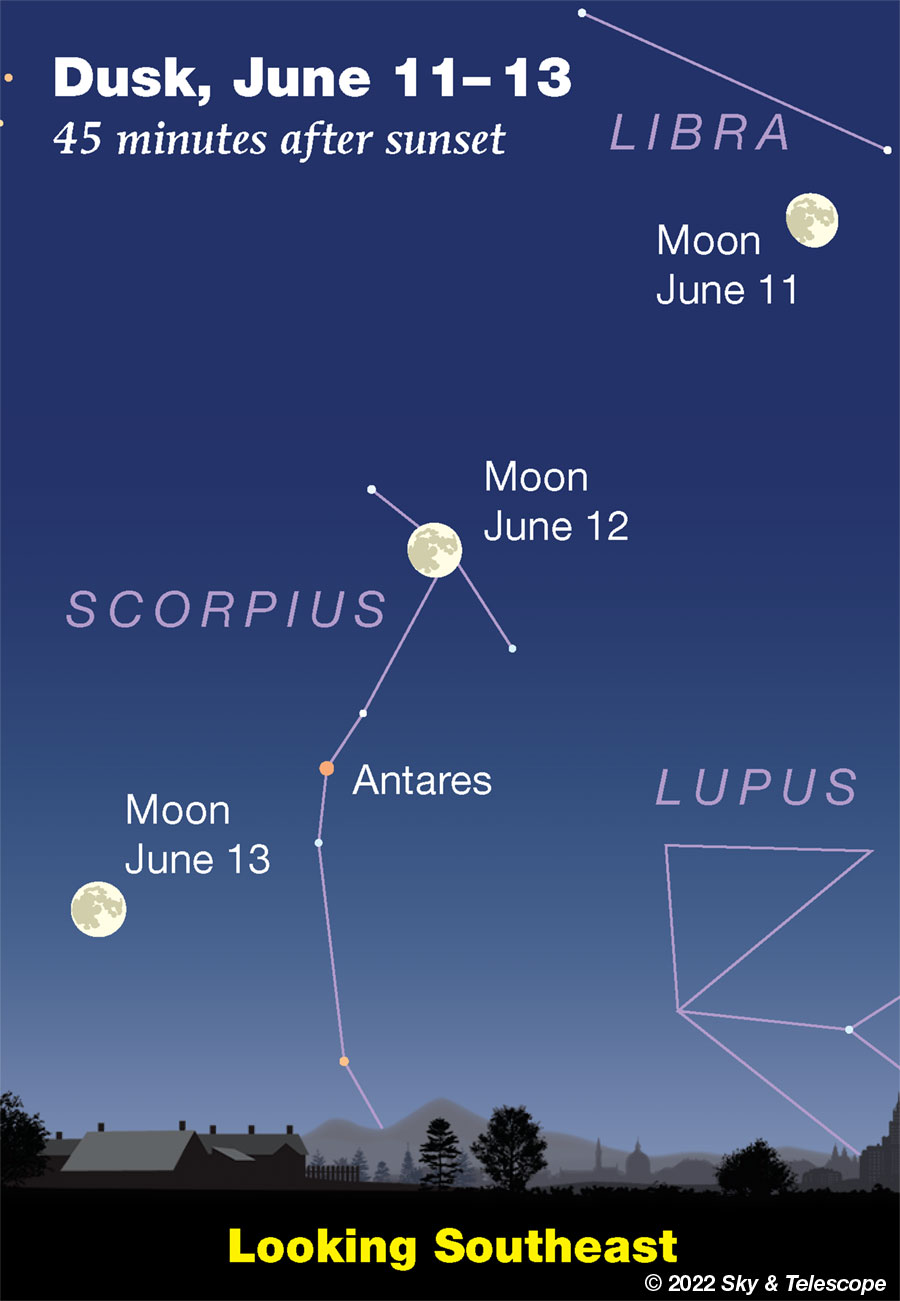
In these illustrations the Moon is drawn about three times its actual apparent size, so in this one it covers up Delta Scorpii. In reality, the Moon will only occult Delta Sco for the northeastern US and eastern Canada; see the June 12 text below.
SUNDAY, JUNE 12
■ The Moon, just a day and a half short of full, shines in the head of Scorpius this evening. Spot Antares less than a fist to its lower left, as shown above.
The Moon will occult Delta Scorpii late this evening for observers in the northeastern US and eastern Canada: north of a line from Cape Hatteras through Lake Michigan to Lake Winnipeg. Delta Sco currently remains bright at about magnitude 1.9 (it's a very long-term variable star), but the moonlight will be intense. The star will snap out of view behind the Moon's dark limb very close to the terminator. So you'll need a telescope. This would be quite the naked-eye occultation if the Moon were, say, a waxing crescent.
Here are a map and timetables. The text has two long timetables: first for the star's disappearance, then for its reappearance from behind the Moon's bright limb. Scroll to the header to be sure you're using the right table. The first two letters in each entry are the country abbreviation ("CA" is Canada, not California.) UT is 4 hours ahead of Eastern Daylight Time.
MONDAY, JUNE 13
■ Full Moon tonight (exactly full at 7:52 a.m. Tuesday morning Eastern Daylight Time). The Moon shines lower left of Antares this evening, as shown above. Meanwhile, Delta Scorpii is up there pretending nothing happened last night.
This full Moon is a supermoon, appearing just a trace larger and brighter than average because it's only a day from perigee. This also means that the usual full-Moon "spring tides" will be even higher and lower than spring tides usually are. Don't sleep on the beach near the usual high-tide line.
TUESDAY, JUNE 14
■ The waning gibbous Moon shines in front of the Sagittarius Teapot late tonight. Use binoculars to pick out the Teapot's 2nd- and 3rd-magnitude stars through the moonlight. The Teapot is sitting level, about a fist-width wide, with its triangular spout on right.
Keep in mind that it's about twice the width of a typical binocular's field of view. You'll need to sweep around a little to piece out all its stars.
WEDNESDAY, JUNE 15
■ As we count down the last few days to summer (the solstice is on June 21st this year), the Summer Triangle stands high and proud in the east after dark. Its top star is bright Vega. Deneb is the brightest star to Vega's lower left, by 2 or 3 fists at arm's length. Look for Altair a greater distance to Vega's lower right. In brightness, Altair ranks midway between Vega and Deneb.
THURSDAY, JUNE 16
■ Here it is five days to summer. But as twilight fades, look very low in the north-northwest for wintry Capella very out of season. Bring binoculars. The farther south you are the lower it will be, and if you're in the southern US, forget it; Capella season is over. But if you're as far north as Montreal or either of the Portlands (Oregon or Maine), Capella is actually circumpolar.
FRIDAY, JUNE 17
■ The waning gibbous Moon rises around midnight with Saturn glowing steadily about 7° to its left. Saturn is magnitude +0.7. Partway between it and the Moon look for Delta Capricorni, magnitude +2.8.
By the beginning of dawn Saturday morning this array is high in the south, now aligned more upright.
SATURDAY, JUNE 18
■ The Big Dipper hangs down by its handle high in the northwest. Spot the star at the end of its handle, the highest one. That's Alkaid, the tail of Ursa Major.
Spot the Sickle of Leo much lower in the west. The brightest star about two fists upper left of the Sickle is Denebola, the tail of a different carnivore: Leo.
About a third of the way from Alkaid to Denebola is a fainter star: Cor Caroli (Alpha Canum Venaticorum).
And what is two thirds of the way along that line? Nothing? Look again, maybe in a darker sky or with wide-field binoculars. You're looking into the big, dim Coma Berenices star cluster.
The cluster's brightest members form a sort of upside-down Y. The entire cluster is about 4° wide — a big, dim, irregular glow in a fairly dark sky, roughly the size of a ping-pong ball at arm's length. It nearly fills a binocular view.
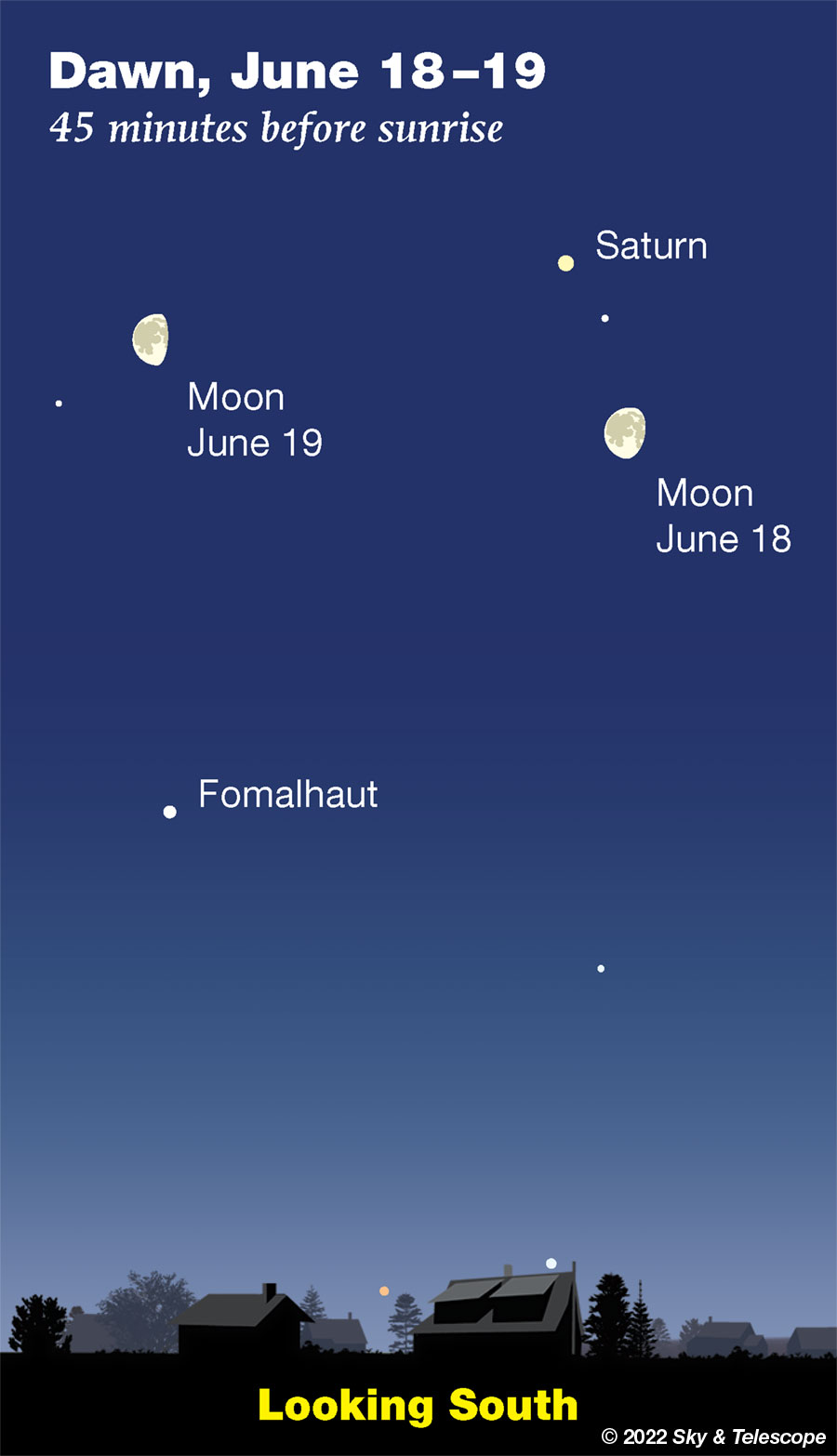
This Week's Planet Roundup
Mercury is low in the glow of sunrise, some 12° lower left of bright Venus all this week as shown below. Mercury is at greatest elongation (23° west of the Sun) on June 16th, but even then it doesn't rise until dawn is already under way. Try for it low about 40 to 30 minutes before sunrise, and bring binoculars.
Mercury brightens from a difficult magnitude +1.1 on the morning of June 11th to a somewhat better +0.4 (i.e. twice as bright) by the 18th. Did I mention binoculars?
Venus (magnitude –3.9) rises soon after the beginning of dawn. Look for it just left of due east. It's very far lower left of bright Jupiter, by four or five fists at arm's length.
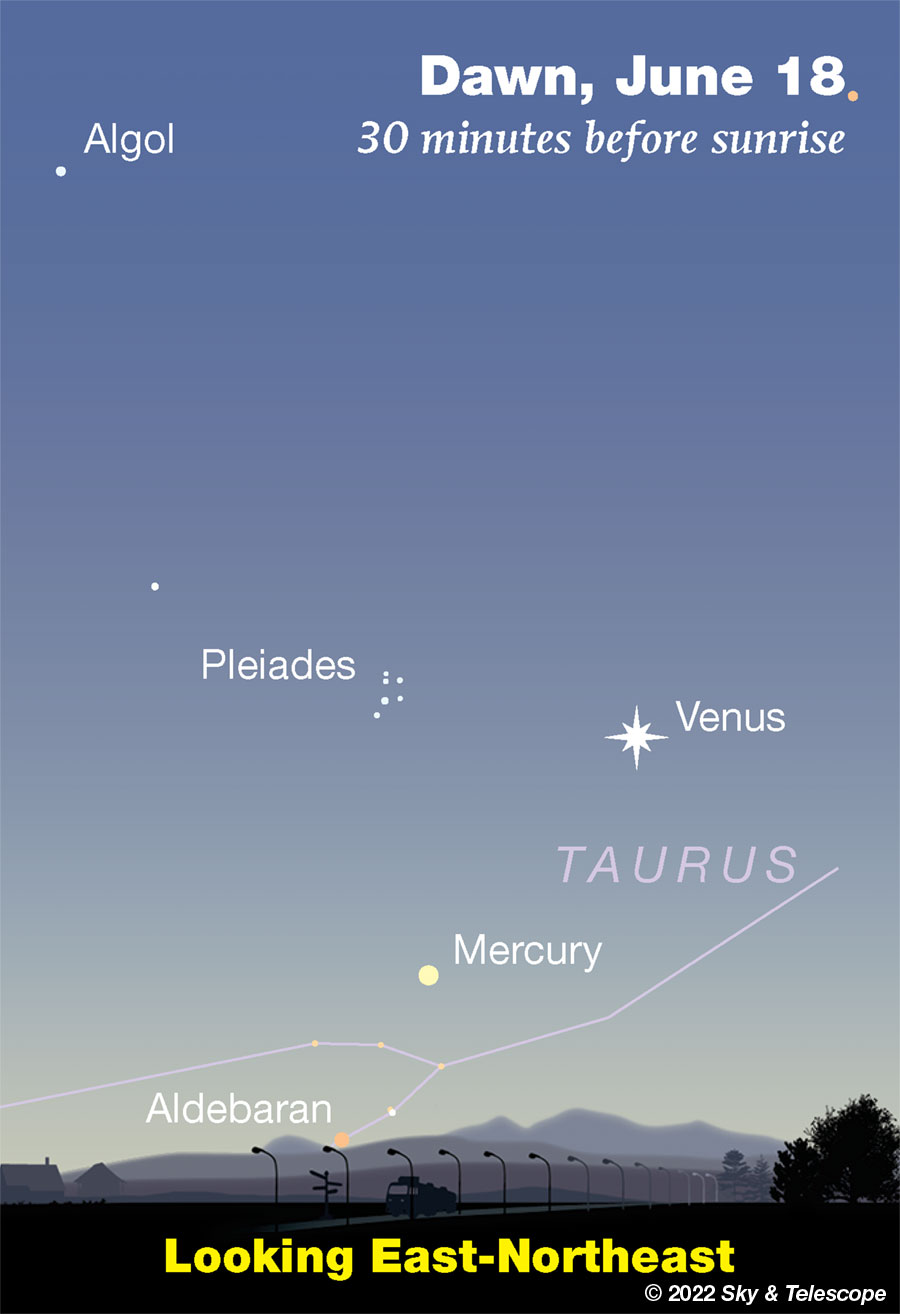
Mars and Jupiter, very different at magnitudes +0.6 and –2.3 respectively, shine in the east-southeast before and during early dawn. From Jupiter, look for little Mars 8° to the lower left on the morning of June 11th. Their gap widens to 12° by the 18th.
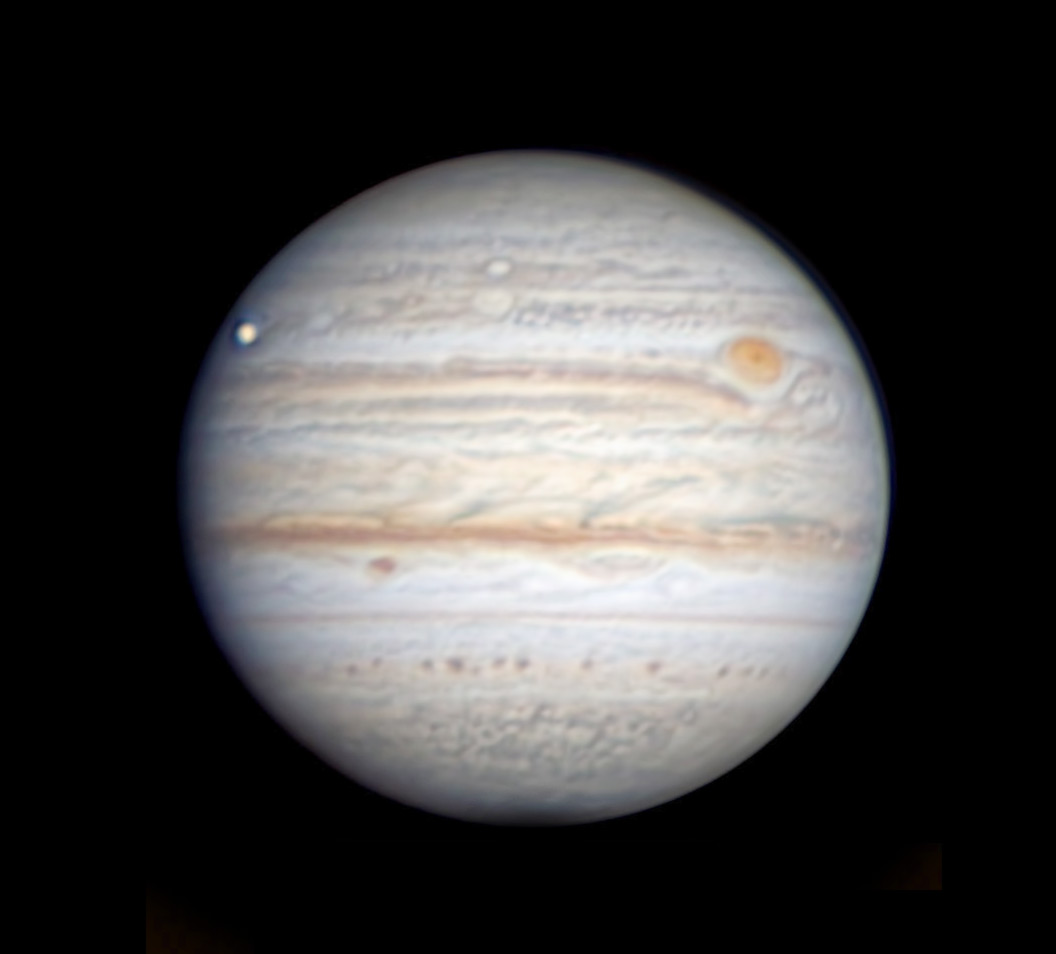
Saturn, magnitude +0.7, glows in eastern Capricornus, some 40° (about four fists) to the right of Jupiter before and during early dawn.
The little star 2° to Saturn's lower right is Delta Capricorni, magnitude 2.8. The reason Delta Cap has been staying there week after week is because Saturn is near its stationary point, the east end of the retrograde loop it performs against the sky every 12½ months. And, since Saturn is quite far away as planets go, its retrograde loop is small. So Delta Cap will keep fairly close company with Saturn all the way through August.
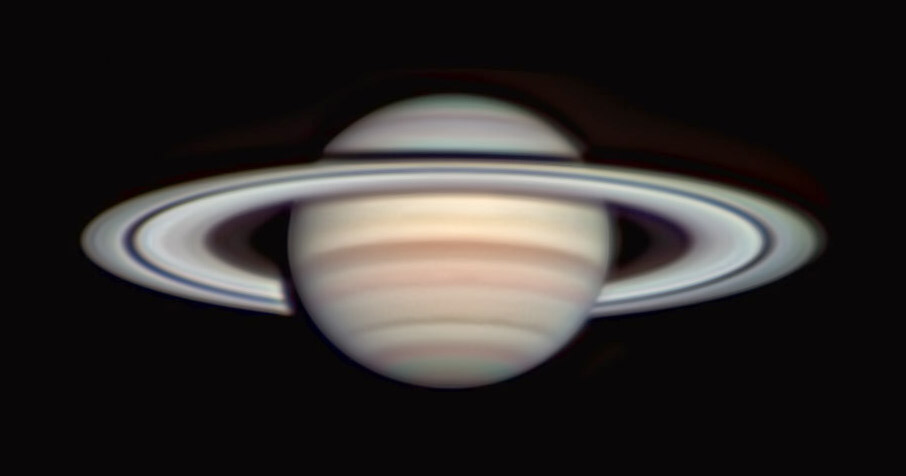
Uranus, magnitude 5.8, is washed out in the eastern dawn far in the background of Venus.
Neptune, magnitude 7.9 at the Aquarius-Pisces border, is 10° west (right) of Jupiter before dawn begins.
Next week, with Mercury brightening and getting a little higher , all five naked-eye planets will form their best lineup in the dawn. And, counting from lower left to upper right, they're already lined up in order of their distance from the Sun!
Moreover, Uranus and Neptune lurk within the same line. And next week the Moon will walk the length of the line, day by day.
All descriptions that relate to your horizon — including the words up, down, right, and left — are written for the world's mid-northern latitudes. Descriptions and graphics that also depend on longitude (mainly Moon positions) are for North America.
Eastern Daylight Time, EDT, is Universal Time minus 4 hours. (Universal Time is also called UT, UTC, GMT or Z time.)
Want to become a better astronomer? Learn your way around the constellations. They're the key to locating everything fainter and deeper to hunt with binoculars or a telescope.
This is an outdoor nature hobby. For an easy-to-use constellation guide covering the whole evening sky, use the big monthly map in the center of each issue of Sky & Telescope, the essential magazine of astronomy.
Once you get a telescope, to put it to good use you'll need a detailed, large-scale sky atlas (set of charts). The basic standard is the Pocket Sky Atlas (in either the original or Jumbo Edition), which shows stars to magnitude 7.6.

Next up is the larger and deeper Sky Atlas 2000.0, plotting stars to magnitude 8.5; nearly three times as many. The next up, once you know your way around, are the even larger Interstellarum atlas (stars to magnitude 9.5) or Uranometria 2000.0 (stars to magnitude 9.75). And be sure to read How to Use a Star Chart with a Telescope. It applies just as much to charts on your phone or tablet as to charts on paper.
You'll also want a good deep-sky guidebook. A beloved old classic is the three-volume Burnham's Celestial Handbook. An impressive more modern one is the big Night Sky Observer's Guide set (2+ volumes) by Kepple and Sanner.
Can a computerized telescope replace charts? Not for beginners, I don't think, and not on mounts and tripods that are less than top-quality mechanically, meaning heavy and expensive. And as Terence Dickinson and Alan Dyer say in their Backyard Astronomer's Guide, "A full appreciation of the universe cannot come without developing the skills to find things in the sky and understanding how the sky works. This knowledge comes only by spending time under the stars with star maps in hand."
![]() Audio sky tour. Out under the evening sky with your
Audio sky tour. Out under the evening sky with your
earbuds in place, listen to Kelly Beatty's monthly
podcast tour of the heavens above. It's free.
"The dangers of not thinking clearly are much greater now than ever before. It's not that there's something new in our way of thinking, it's that credulous and confused thinking can be much more lethal in ways it was never before."
— Carl Sagan, 1996
"Facts are stubborn things."
— John Adams, 1770
 15
15









Comments
Anthony Barreiro
June 10, 2022 at 4:37 pm
Here in San Francisco, latitude 38 degrees north, Capella has been visible during dawn for the past few days.
You must be logged in to post a comment.
cyrtonyx
June 12, 2022 at 7:14 pm
Grew up in the Bay Area. Light pollution always was an issue with my stargazing as a teen. Move to NM in 2002. Skies so dark here, that one can view 3rd magnitude stars on the horizon.
You must be logged in to post a comment.
mary beth
June 13, 2022 at 12:23 pm
Cyrtonyx, that sounds beautiful. Do you still get up early to enjoy dawn skies, even though school is out?
You must be logged in to post a comment.
mary beth
June 13, 2022 at 12:25 pm
Thank you this is a detailed and understandable post. I’m going to share it with others, a lot of people don’t understand anything about the position of the sun. Sadly I think a lot of my friends think it rises exactly in the east and sets in the west every day. They don’t give it any thought but I am in love with the “pilgrimage of the sun” Credit that to author Henry Beston
You must be logged in to post a comment.
cyrtonyx
June 16, 2022 at 3:37 pm
Yes. In fact I am up periodically in the wee hours of the morning...I have a new puppy. While waiting for him to do his business, I can star gaze for a few minutes. Beautiful moon these last few mornings.
You must be logged in to post a comment.
mary beth
June 16, 2022 at 8:35 pm
Oh how fun! I remember watching Orion st 4 a.m. one early autumn with my puppy! Enjoy your new pup and the night lights!
You must be logged in to post a comment.
mary beth
June 13, 2022 at 12:22 pm
Hi Anthony! Do you think you can see Capella almost 365 days a year?
You must be logged in to post a comment.
Bortle10
June 11, 2022 at 4:59 am
Are you sure about the full moon being on the 13rd? Shouldn't that be the 14th?
You must be logged in to post a comment.
misha17
June 12, 2022 at 10:47 pm
The Solstice is still a week away, but sunrises in the Northern Hemisphere are already beginning to occur a minute later each morning. The loss of morning light is more than offset (for now) by the gain in evening light - Sunset is occurring a minute or so later each day, but that daily rate is slowing. Latest sunset time in the Northern Hemisphere occurs the last week of June, but after the solstice the later sunrise times will offset the later sunset times.
You must be logged in to post a comment.
misha17
June 12, 2022 at 11:51 pm
The loss of morning light (and gain in evening light) is due to the fact that Solar Noon (when the Sun crosses the meridian and is highest in the sky) usually does not occur at 12:00 Noon (Mean Noon), due to the (apparent) motion of the Sun along the ecliptic, and due to the fact that the earth;s orbit is not circular. This time of year Solar Noon occur after 12:00 (Mean Time), and will occur a little later each day for a couple of months. Sunrise is still occurring a little earlier each day compared to Solar Noon, but increasing lateness of Solar Noon compared to "Mean Time" Noon "drags" the sunrise time later in "Mean Time".
You must be logged in to post a comment.
mary beth
June 13, 2022 at 12:26 pm
I replied but I put it in the wrong place,above . Thanks for your post.
You must be logged in to post a comment.
Tony
June 14, 2022 at 7:02 pm
The earliest/latest sunrises/sunsets happen closer to the solstice date as one moves closer to the polar circles. So, while most of the USA has already seen its earliest sunrise of 2022, most of Canada has yet to. At Latitude 50N the earliest sunrise happens on June 17.
You must be logged in to post a comment.
Rod
June 13, 2022 at 7:40 am
"The Moon will occult Delta Scorpii" I was able to view this event last night using my 90-refractor telescope at 31x. [Observed 2200-2230 EDT. Full Moon 14-Jun-2022 1152 UT. Lunar occultation at 2224 EDT using my flip phone time of the bright star delta Sco. That is when Dschubba disappeared behind the Moon in the eyepiece view. Some altocumulus bands moved by but when occultation time, the observations in the clear. Dschubba star is very bright. It was easy to see as the Moon moved closer and closer to the star. The Moon occulated the star in the southern limb, Tycho crater quite prominent in the eyepiece. This was enjoyable to view but I did not stay until Dschubba reappeared again.]
You must be logged in to post a comment.
mary beth
June 13, 2022 at 12:27 pm
Very nice Rod! I was hoping you had clear weather for this!
You must be logged in to post a comment.
Rod
June 15, 2022 at 9:41 am
This morning near 0500 EDT, I noticed Jupiter is very prominent in the SE sky in Pisces. Stellarium 0.22.1 shows it up about 35-degrees elevation. I could setup my10-inch but that is hauling some 60 lbs out into my pastures. Perhaps I will view soon using my 90-mm refractor telescope on tripod. Jupiter is close to 39 arcsecond angular size now according to Stellarium.
You must be logged in to post a comment.
You must be logged in to post a comment.